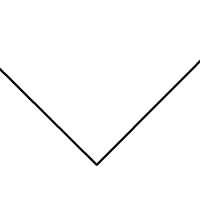AREAS OF KNOWLEDGE: MATHEMATICS
IMAGINING GEOMETRY—A ThoUght Experiment!
LET’s TRY It…
Sit comfortably, close your eyes—and keep them closed throughout this thought experiment. Notice your own gentle breathing, and any background noise, but do not focus on them. They are mere distractions. Forget the real world with all its messiness. Try to keep your thinking—at least for the next few minutes—abstract, austere, ideal, cold and pure.
Imagine an empty space. A perfect, infinite, timeless, silent, empty space—where ordinary physical objects simply do not exist.
Next, imagine a single, tiny dot in your timeless empty space. Just a unidimensional dot. A lonely, infinitesimal dot that has no size, no mass, no shape or color. Nevertheless, imagine it in your perfect space. It has its place there. There is a certain beauty in the simplicity of that. It marks a spot. It represents a position; but it is infinitely small, with no physical attributes at all. It is entirely in your head. A contrived, conjured up, minuscule figment of your imagination. The tiniest, purest, loneliest, singular, perfect, cutest little dot imaginable.
Hold the vision of that dotty perfection, that unsullied thought, in your consciousness just for a moment. Next, in your mind’s eye imagine a second infinitesimal dot, near your first infinitesimal dot.
Next imagine the shortest distance between your two dots. In your mind’s eye draw that perfect straight line.
Now add a third dot near your original straight line. Recreate that perfect straight line that was the he shortest distance between your two dots. Next, in your mind’s eye, join the two ends of your straight line to your third dot by the shortest routes. Then, take a moment to appreciate the perfection of the triangle you have just invented.
Let’s pause
Open your eyes. Relax in silence for a few moments.
MORE mathematical imagining
Get ready to immerse yourself, for a second time, in an imaginative realm that is abstract, austere, ideal, cold and pure? Sit comfortably, close your eyes—and keep them closed. Again, notice your own gentle breathing, and any background noise emanating from the messiness of the real world.
Now, forget the triangle that you invented. Let’s invent something entirely new. Think back to your two imaginary, infinitesimal dots, and the single straight line formed by tracing the shortest distance between them. Imagine that one end of your line is fixed in place at the dot, while the other end rotates freely around it—slowly, in one direction—until it returns gently, and precisely, to its starting position. Consider carefully the curved path that the tiny moving dot at the end of your line has taken. Congratulate yourself because you just invented a pristine, immaculate circle!
Notice that with that simple thought experiment you also invented the idea of a full turn.
Also notice that when your line was rotated by only half of that full turn it formed a perfect straight line with its starting position. So we can also think of half a full turn as a straight line. Pause to appreciate the purity and beauty of the semicircle you just conjured up in your mind’s eye. Notice that the straight line base is the diameter, and your original line is the radius.
Now let’s play with your semicircle in three dimensions. In your mind’s eye rotate the semicircle around its diameter, a full turn. You just imagined a perfect three dimensional sphere.
Now go back to your circle. Clone it in your mind's eye; keeping it precisely where it is. Then imagine slowly pulling the cloned circle perpendicularly to the parent circle base to make a perfect cylinder. Notice that the two circular ends are parallel.
Next, return again to your original circle and, this time, imagine pulling its center point. Well done, indeed! You have just invented a cone. If you then slice your cone, in your mind’s eye, exactly parallel to the original circular base, notice that you get a smaller perfect circle looking from the top. If you repeat the thought experiment and make a slice that is sloppy and not parallel you just invented an ellipse.
We could keep going, but this elaborate thought experiment is already a lot to keep in your head.
So what just happened?
You started from a single, titchy, imaginary dot. From this foundational point you invented and named simple geometric objects and some emergent relationships between them. You also concocted one, then two, then three dimensions!
If we kept going and worked more systematically, recording our thoughts on paper, we could invent the axioms of Euclid, and build them to “invent” (or some might say “discover”) the entire edifice of geometry.
Now, open your eyes—welcome home to the real world!
Bisection construction: Wikimedia commons

